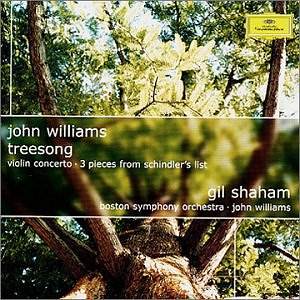 John WILLIAMS (b. 1932)
John WILLIAMS (b. 1932)
Works: Treesong (2000); Violin Concerto (1974–76, rev. 1998); Three Pieces from Schindler’s List (1993)
Performers: Gil Shaham (violin), Boston Symphony Orchestra, John Williams
Recorded: Boston, 1999 & 2000
Label: DG 471 362-2
Duration: [66:05]
The recording opens with Treesong, a work that evokes an ethereal atmosphere, shimmering like sunlight filtering through leaves in a forest. Williams’ orchestration here is notably evocative, utilizing a palette of colors that suggest both the delicate and the expansive. The solo violin’s voice often emerges as a solitary figure amidst the lush orchestral backdrop, demanding an interpretative depth that Shaham delivers with remarkable sensitivity. His ability to spin a lyrical line resonates deeply, revealing a nuanced understanding of the piece’s inherent poeticism.
In contrast, the Violin Concerto—revised in 1998—exhibits a robust classical structure, reminiscent of Prokofiev and Walton yet ultimately distinctive in its voice. Shaham’s interpretation of the opening movement showcases his technical prowess and interpretative insight. The opening bars, which leap across two-and-a-half octaves, are executed with precision, establishing an immediate sense of urgency and vitality. The outer movements are laden with a frenetic energy; Shaham navigates the virtuosic demands with an ease that belies the concerto’s technical challenges.
Notably, the slow movement of the concerto is a highlight, revealing a heart-stopping pianissimo that is, at once, haunting and transcendent. Shaham’s tone here is rich and full-bodied, yet it retains an intimate quality that invites the listener into a shared emotional space. This moment, akin to Walton’s own lush lyricism, solidifies Shaham’s position as a violinist of extraordinary caliber—a true heir to the legacy of Itzhak Perlman, whose interpretation of these works remains elemental and unmatched.
The three pieces from Schindler’s List serve as a poignant bridge between Williams’ cinematic and concert works. Here, Shaham’s tonal refinement shines through. While Perlman’s original recordings are iconic for their emotional weight, Shaham offers a different perspective—one that marries elegance with a subtle depth of expression. The recording quality complements this performance beautifully; the orchestral sound is both spacious and detailed, allowing each nuance of the violin’s voice to emerge distinctly against the orchestral fabric.
The engineering of this disc deserves particular commendation. The clarity of the orchestral textures ensures that the listener can appreciate Williams’ kaleidoscopic orchestration, where woodwinds, brass, and strings intertwine with a vividness that enhances the overall experience. The balance between soloist and orchestra is expertly managed, allowing for an interplay that is both dynamic and cohesive.
Historically, Williams’ concert works have often been overshadowed by his film scores. However, pieces like Treesong and the Violin Concerto reveal the composer’s sophisticated grasp of orchestral form and his ability to convey deep emotional narratives within a concert setting. These works exemplify the seamless blend of popular and classical idioms, thereby broadening the scope of what we consider American concert music.
In conclusion, this recording not only highlights Gil Shaham’s exceptional artistry but also underscores John Williams’ significant contributions to the concert repertoire. Both the Boston Symphony Orchestra and Williams himself provide a committed and vibrant performance that underscores the works’ lyrical and dynamic qualities. The result is a beautifully recorded disc that warrants a place in the collections of both film music aficionados and classical enthusiasts alike.